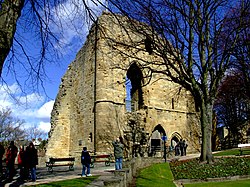Knaresborough Castle
| Knaresborough Castle | |
|
Yorkshire | |
|---|---|
 The ruined keep of Knaresborough Castle | |
| Location | |
| Grid reference: | SE349569 |
| Location: | 54°0’26"N, 1°28’10"W |
| Town: | Knaresborough |
| History | |
| Built Around 1100, rebuilt 1301–1307 | |
| Information | |
| Condition: | Ruined |
| Owned by: | Duchy of Lancaster (in the care of Harrogate Borough Council) |
Knaresborough Castle is a ruined fortress overlooking the River Nidd in the town of Knaresborough, in the West Riding of Yorkshire.
History
The castle was first built by a Norman baron in around 1100 on a cliff above the River Nidd. There is documentary evidence dating from 1130 referring to works carried out at the castle by Henry I.[1] In the 1170s Hugh de Moreville and his followers took refuge there after assassinating Thomas Becket, Archbishop of Canterbury.
In 1205 King John took control of Knareborough Castle.[2] He regarded Knaresborough as an important northern fortress and spent £1,290 on improvements to the castle. The castle was later rebuilt at a cost of £2,174 between 1307 and 1312 by Edward I and later completed by Edward II, including the great keep.[3] John of Gaunt, 1st Duke of Lancaster acquired the castle in 1372, adding it to the vast holdings of the Duchy of Lancaster.
The castle was taken by Parliamentarian troops in 1644 during the Civil War, and largely destroyed in 1648 not as the result of warfare, but because of an order from Parliament to dismantle all Royalist castles. Indeed, many town centre buildings are built of 'castle stone'.
The castle today
The remains are open to the public and there is a charge for entry to the interior remains. The grounds are used as a public leisure space, with a bowling green and putting green open during summer. It is also used as a performing space, with bands playing most afternoons through the summer. It plays host to frequent events, such as FEVA.[4] The property is owned by The Queen in right of the Duchy of Lancaster, but it is administered by Harrogate Borough Council.
Description
The castle, now much ruined, comprised two walled baileys set one behind the other, with the outer bailey on the town side and the inner bailey on the cliff side. The enclosure wall was punctuated by solid towers along its length, and a pair, visible today, formed the main gate. At the junction between the inner and outer baileys, on the north side of the castle stood a tall five-sided keep, the eastern parts of which has been pulled down. The keep had a vaulted basement, at least three upper stories, and served as a residence for the lord of the castle throughout the castle's history. The castle baileys contained residential buildings, and some foundations have survived.
The upper storey of the Courthouse features a museum that includes furniture from the original Tudor Court, as well as exhibits about the castle and the town.[1]
Outside links
- Knaresborough Castle
- Knaresborough Castle & Museum - Harrogate Borough Council
- Knaresborough Castle on Castlexplorer.co.uk
References
- ↑ 1.0 1.1 "History of Knaresborough". knaresborough.co.uk. http://knaresborough.co.uk/history/#tab-1430853169252-14-10.
- ↑ Brown 1959, p. 256
- ↑ King 1983, pp. 520, 537
- ↑ "Knaresborough Festival". feva.info. http://www.visitharrogate.co.uk/events/feva-knaresboroughs-festival-of-visual-arts-and-entertainment-p1230751.
- Brown, R. Allen (April 1959), "A List of Castles, 1154–1216", The English Historical Review (Oxford University Press) 74 (291): 249–280, doi:10.1093/ehr/lxxiv.291.249
- Fry, Plantagenet Somerset, The David & Charles Book of Castles, David & Charles, 1980, p. 249. ISBN 0-7153-7976-3
- King, David James Cathcart (1983), Catellarium Anglicanum: An Index and Bibliography of the Castles in England, Wales and the Islands. Volume I: Anglesey–Montgomery, Kraus International Publications